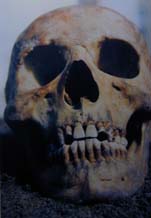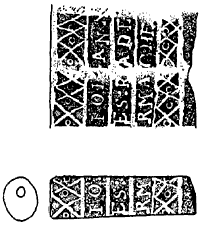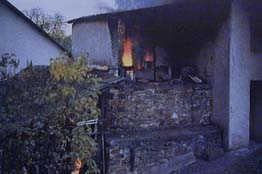No. 12/1999, p. 1-4
Martin Kügler: Report on the 12th meeting of the German
Society for Clay-Pipe Research,
held in Passau on 22-24 May 1998
Altogether 33 people attended the meeting, which was held at the
invitation of the Oberhaus Museum in Passau. Clay-pipe finds from
the Veste Oberhaus, most of them from the 17th century, which were
incorporated in the exhibition entitled "Knight's castle and
prince's palace", were introduced by M. Kügler. R. Kluttig-Altmann
reported on clay-pipe finds from Leipzig and gave a preliminary
account of those found between 1990 and 1997 (Knasterkopf No. 11/1998,
p. 49-55 and No. 12/1999, p. 74-82). M. Weidner reported on clay-pipe
finds from Rendsburg Neuwerk (Knasterkopf No. 12/1999, p. 4-13)
and W. Morgenroth gave a paper on the development of the detachable
pipe stem. Clay pipes from the Adriatic was the subject of a paper
by R. Articus (Knasterkopf No. 12/1999, p. 60-73). L. Libert showed
a film on "Tobacco growing in the Uckermark", which was
made in 1997. The excursion visited the Kropfmühl graphite
mine, the Oberzell Ceramics Museum, Wolf and Ruhland's cigar factory
in Perlesreuth and the Grafenau Snuff Museum.

|
|
|

|
No. 12/1999, p. 4-13
Maren Weidner: Archaeological finds at the "Neuwerk"
of Rendsburg
Numerous skeletons have been found in the Neustadt part of Rendsburg,
Schleswig-Holstein. It appears that the corpses had been buried hurriedly
without coffins. Many clay-pipe fragments were found amongst the bones,
and these can be used not only to date the burial but also as evidence
for the circumstances under which it took place. The idea that the
skeletons were those of plague victims is not supported by the fact
that the last plagues in Rendsburg were in 1705 and 1711, and the
pipes are mostly younger than this. Even though analysis of the pipes
provides no explanation for the occurrence of the many skeletons,
the pipes still refute the original theory. Indirectly, however, they
do give important evidence about the dating of the skeletons (which
so far has not been possible in spite of the anthropological studies
carried out), since many of the skulls show clear signs of abrasion
of the teeth. Four teeth, the canine and the first molar on the top
and bottom, are invariably abraded, making a roundish space between
the four teeth, which is clearly the result of years of smoking clay
pipes.
Human skull from the Pauli cemetery in the Neustadt
part of Brandenburg showing teeth worn down by abrasion

|
|
|
No. 12/1999, p. 14
Rüdiger Articus: A Westerwald clay pipe from Schleswig-Holstein
It is not often that products of Westerwald clay-pipe makers
are found in Schleswig-Holstein. One such find has an inscription
that identifies it as a product of the clay-pipe maker Johannes
Radermacher (born 1745, died 1802), who worked in Hilgert,
Westerwald.
Fragment of pipe stem with the inscription
IOH / ANN // ES:R / ADE // RMA / CHE,
made by Johannes Rademacher in Hilgert, Westerwald at the
end of the 18th century
|
|
 |

|
|
|

|
No. 12/1999, p. 15-25
Richard Riemann: Clay-pipe finds in Petershagen-Windheim
About 1100 clay-pipe fragments have been collected from fields around
Petershagen-Windheim. Most of them date from the 18th century and
originate from German clay-pipe makers, such as Johann Friedrich Iser
in Hildesheim, Johann Thomas Erdmann in Holzminden, and Elias Noll
in Wahmbeck, as well as unknown pipe makers in Hameln, Münden,
Uslar and Grossalmerode. Other fragments are imports from Gouda and
Amsterdam in the Netherlands.
Stem fragment bearing the name (?Gerhard Johann) Friedrich
Göbel of Grossalmerode,
beginning of 19th century

|
|
No. 12/1999, p. 25-29
Klaus-Peter Schweickert: Clay-pipe finds in the River Aller in
Walbeck (Ohre District)
Some of the clay-pipe fragments found at Walbeck are undoubtedly
imports from the Netherlands. However, numerous pipes bear the inscription
"C.H. BOSSE/IN WALBECK".
They are clearly identifiable as waste from a clay-pipe maker´s
workshop. Pipes found at the same site bear the inscription "VIVAT
LU(NEBURG)/(BR)AUNSCH(WEIG)" and may also have been made in
Walbeck, although this is not certain.

Pipe with heel, bowl surrounded by ornament of
stylised leaves,
firing reject from a clay-pipe factory in Walbeck, end of 18th century

|
|
|

Meerschaum pipe,
so-called swan-neck,
from Lemgo (?),
around 1820
|
No. 12/1999, p. 30-59
Walter Morgenroth: The end of a legend. Meerschaum pipe production
in the 17th and 18th centuries
Meerschaum pipes were part of Turkish cultural life from the first
half of the 17th century onwards, and they found their way into the
possession of Christian smokers from German-speaking countries as
booty brought back from the wars. The legend about the cobbler in
Budapest, who was supposed to have been the first person to produce
meerschaum pipes in 1723, can now definitely be refuted. Before this
time, meerschaum pipes were exported from Turkey to the Balkans and
then marketed elsewhere. About 1750, production of meerschaum pipes
started in Ruhla (Thuringia) and Lemgo (Westphalia); initially rough-cut
blanks were imported from Turkey and finshed off in Germany. But in
the first half of the 18th century, blocks of raw meerschaum were
also imported in small quantities. The large amount of waste produced
led to the development of "artificial meerschaum". A method
was developed of compressing the waste into blocks, which were then
shaped into pipes in the same way as with blocks of natural meerschaum.

|
|
|
No. 12/1999, p. 60-73
Rüdiger Articus: Clay pipes from Italy
Four clay-pipe bowls found in the northern Adriatic Sea provide
an opportunity to give a summary of clay-pipe making in Italy. A
brief overview explains how the Italian products differ from region
to region. The most important production centre, Chioggia, which
is the district capital of the province of Venice, is described
in more detail. Clay-pipe production started here, possibly influenced
by Turkish products, as early as the middle of the 17th century,
and died out in 1945.
| One of the characteristic features of the Chioggia
pipes is that they have three holes in the pipe bowl leading
into the stem bore. The clay pipes can be shown on the basis
of shape to belong to three periods: 1750 and earlier, 1750-1850,
and 1850-1945. The annual production in the middle of the 19th
century was 4 million pipes. Attempts to stimulate the pipe-maker´s
craft, which was often only a side-line, were unsuccessful and
could not prevent the craft dying out in the 20th century. |
|

zoom
|

|
|
|
No. 12/1999, p. 74-82
Ralf Kluttig-Altmann: Clay pipes in Leipzig - a preliminary
report on new finds since 1990
Since 1990, many excavations in the city centre of Leipzig
have produced numerous clay-pipe fragments. About one third
of the finds from ten excavations have been evaluated: there
is a marked dominance of 18th century imports from Gouda.
The inscription on the stems or the marks document the following
makers: Jan van der Dus, Jan Danens, the Jong family, Hendrik
Mandshofd, J. de Vos, Arij van der List and Peter Versluijs
- the most common were made by the Verzijl family. In contrast,
very few Dutch pipes have been found so far dating from the
17th century, and only a few pipes provide evidence of other
production centres, e.g. Grimma in Saxony. This distribution
in time, which in view of the general evolution of the clay
pipe is somewhat unusual, will be critically examined when
the finds are analysed. One unusually large pipe bowl bearing
an unsually large mark on the spur has not yet been identified.
|
|
Pipe with heel, bowl unusually large,
heel mark is a crowned 4-leaf clover
with the letters R & B,
provenance and age not known
|

|
|
No. 12/1999, p. 83-88
Günter Unteidig: A clay-pipe kiln in Grimma, Saxony
The pipe-making industry in Grimma, NW Saxony, has been studied
on the basis of documentary evidence, as well as a few finds in
excavations, and described by Bernd Standke in Knasterkopf No. 10/1997.
It is now possible for the first time to report on a clay-pipe kiln.
The Kramer family produced clay pipes between 1792 and the middle
of the 19th century in house No. 7 in Mühlenstrasse in Grimma.
The kiln was taken over from a potter who used to work there before.
The kiln, which was built up against the city wall, was somewhat
rebuilt to suit the clay-pipe maker. The fire was situated in front
of the kiln, and the heat, flames and smoke were led in duts beneath
the kiln itself. The box-shaped saggars, which were stacked on a
grid made of ceramic slabs, were enveloped by the flames during
the firing.

Pipe kiln belonging to E. Günther at the time of transition from
briquette firing to wood firing, Hilgert, Westerwald, 1990
|
|
